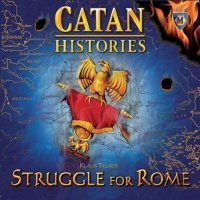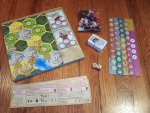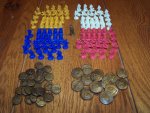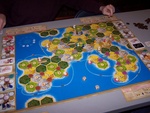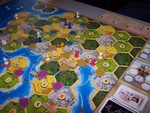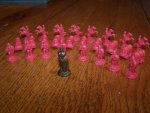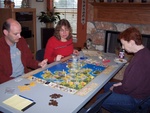
|
Struggle for Rome A game by Klaus Teuber Published by Kosmos Games and distributed in the US by Mayfair Games, Inc. Players: 3-4 Time: 90-120 minutes Reviewed by Susan Rozmiarek |

|
Struggle for Rome is the second game is the Catan Histories series following Settlers of the Stone Age. Both games take core elements from the popular Settlers of Catan game and add a historical theme and unique twists to the game play. Struggle for Rome is themed around the invasion of the Western Roman Empire by Germanic tribes in the 4th Century AD. Players will each control two tribes that will be wandering through the Roman Empire, plundering and conquering Roman cities and establishing their own kingdoms.
Components:
- Game Board - this is a very large (six fold) and colorful hex map of the Western Roman Empire.
- Sets of plastic, sculpted miniatures in four player colors. Each includes 10 supply wagons, 8 warriors, and 8 horsemen.
- 1 plastic sculpted Roman Legionnaire
- 2 wooden dice
- 40 plunder counters in 5 colors
- 40 plastic gold coins sculpted to look like ancient coins. There are two sizes to indicate denominations of either 1 or 5. They are really nice looking but I wish the two sizes were of different colors as they were easy to confuse.
- 4 player's aids. These are very helpful but are made of flimsy, shiny paper rather than heavy cardboard like the ones in Settlers of the Stone Age. I suspect that I will eventually laminate mine.
- 4 white markers with crosses
- 90 cards including resource cards, development cards and special victory point cards. These are of slightly thinner stock than the cards in Settlers of the Stone Age, but seem to holding up well to use so far.
- A well written, nicely illustrated color rulebook. It does fold out rather than being in booklet form which is rather annoying.
Although the game is not all that complicated, a great online tutorial can be found at Professor Easy's interactive game tutorial.
Game play:
The map shows some of the familiar terrain hexes with numbers, however in this game forests do not produce. Rather than sheep, the pastures produce cattle or horses (drawn randomly) and mountains still produce ore. Fields produce grain. The final resource in the game is money, which is represented by neat plastic coins molded (presumably) like real Roman coins. The game has a Roman Legionnaire that acts like the robber in Settlers, shutting down resource production on a hex and allowing the player to steal a resource card randomly from a player who has a tribe on that hex. However, there is no resource card hand limit forcing players to discard cards. Like Settlers, there is a deck of development cards with special abilities, straight victory points and Diplomats which are played like the Army cards with a victory point bonus card for the player who has the most.
Despite the similarities to the original game, Struggle plays quite differently. At the corners of many of the hexes across the board are cities. Each city starts with a face down plunder token. The back of each token is one of five colors and these colors divide the board into five different regions. Unlike Settlers, the beginning of the game is far from fixed. Instead of placing two settlements, players have two tokens, a Horseman, and a Warrior. These are placed on predetermined starting locations in a corner of the board just outside the Roman border. They represent two invading tribes that each player controls. Players have boxes on the board which contain the actual number of troops and supply wagons in each tribe. More troops and supply wagons and development cards are the three things you'll be "building" during the game. During a turn, players will be wandering around the map, plundering cities and eventually conquering them. The farther they move in a turn, the more it will cost in either grain and/or money and there are both land and sea routes. Arrows on the board along hex edges determine the cost. The more arrows the tribe figure goes over, the higher the cost. This can result in some "analysis paralysis" as players try to find the cheapest route to get where they want to go. Tribes can move through other tribe figures and cities but not end their turn on them. There is not much blocking during this part of the game.
Cities have a certain number of towers and players must have at least that many troops in their tribe to plunder or conquer them along with having the wandering tribe figure located on an adjacent spot to the targeted city. When they plunder a city, they take the facedown token. On the back, it shows bounty they receive which could be money (often based on how many supply wagons the tribe has), a resource card or a development card. On the more valuable tokens, there is a cost in troops and the player must discard a troop from their tribe box. Players cannot conquer a city until that tribe has collected plunder tokens from at least three regions. When they conquer a city, they must place the wandering tribe figure in the city along with a supply wagon for the tribe's box. The tribe is now fixed and doesn't wander any more. Instead, it spreads out by conquering neighboring cities. Conquered cities are like the settlements in Settlers and are worth one victory point each.
Some interesting innovations have been added to the way a game round works. Unlike the original game and every other version that I've played, each player does not do all the different phases before the next player's turn. Instead, each phase of a round is done in turn order by all the players before doing the next phase. The phases of a round in Struggles for Rome are as follows:
- Roll for resources
- Trading and Building
- Horseman tribe action
- Warrior tribe actions
Development cards: Players are allowed to play one development card in each of the phases of a round, except for the first phase. There are cards in the deck that provide nice special abilities like teleporting a tribe figure to anywhere on the board or that allow a city to be conquered or plundered with fewer troops. There are a few straight victory point cards worth one point each as well as the Diplomat cards explained above.
The game feels like it has two very distinct parts. Unlike the original Settlers of Catan but similar to Settlers of the Stone Age, the beginning of the game is far from static. Players are constantly moving around the board, trying to get in position to plunder cities for which they have enough troops to do so while also positioning their tribe figures on hexes favorable for resource rolls. With only two tribe figures, resources are scarce but plundering provides an occasional resource but more importantly gold for buying needed resources and moving across the board in a race to plunder cities before other players. Horses are critical during this part of the game as players need to be constantly building more troops. Players have to plunder cities from at least three different provinces before they can conquer so tribes have to at least wander around board some. But, there is also a tempting two victory point bonus to try for called "Scourge of Rome" awarded to each tribe that collects at least one plunder marker from all five provinces. This is potentially four victory points if both your tribes can accomplish it.
The second part of the game for players starts when they conquer a city with one or both tribes. Now that tribe is settled in place and doesn't wander any more. Instead, the player now tries to conquer more cities and expand that tribe's kingdom. However, it can only conquer cities that are one arrow away from a city the tribe has already conquered. So now, blocking other players and having room to expand is very important. Not only is each conquered city worth a victory point, it also generates resources when the numbers on the hexes it borders are rolled. Because of this, choosing a first city to conquer in a good location is very important. Once both tribes have settled, a player's focus completely changes. The ability to get gold is gone and it is now crucial to build the expensive supply wagons since one is required, along with a troop, for each conquered city. The game seems to escalate now toward the finish, as players get more and more resources quicker as they conquer more cities.
A crucial part of a player's strategy is when to change over to this second part of the game by settling his tribes in fixed locations. If he delays too long, other players will grab the best locations and he may find himself with little area to expand when he does settle. However, it is tempting to continue collecting plunder tokens to achieve the Scourge of Rome bonuses. If other players choose this strategy though, there are often not enough tokens to collect even with a limit of two per province per player. Besides getting the best locations, settling both tribes as early as possible has its own reward. If a player's two tribes each conquer four cities, he immediately gets an "Heir to Rome" card that awards a bonus of two victory points. He now has the ten points needed to win the game - eight for the cities and two for the bonus. I've seen both of these strategies win the game as well as a more mixed one.
Once a player gets ten victory points, he announces it and the current round is finished. The player with the most victory points wins the game with most gold as the tiebreaker.
The game works equally well with three players as it does with four. With three, the map is essentially shrunk by a neutral color occupying some of the cities.
Comments:
I have to admit up front that I am a really big fan of the various incarnations of the Settlers of Catan game. I thought that the original game was very good, but it is the added theme, complexities and tweaks to the system that has resulted in even superior games like Settlers of the Stone Age and Settlers of Canaan. Struggle for Rome is no exception. It is very well-balanced and has multiple strategies to pursue. My games have been tightly contested races with lots of tension. Like Settlers of the Stone Age, I do have concerns that the fixed map will limit its replay ability. The game also runs a bit too long at two to three hours. Even with these concerns, I feel it is a worthy addition to any Catan fan's collection. I greatly look forward to the next game in the series.
| Other Web information: |
This page viewed
E-mail Ed Rozmiarek with questions or problems concerning this page.
Copyright © 2007, Ed & Susan Rozmiarek. No portion of this website may be reproduced or copied without the consent of Ed or Susan Rozmiarek.
